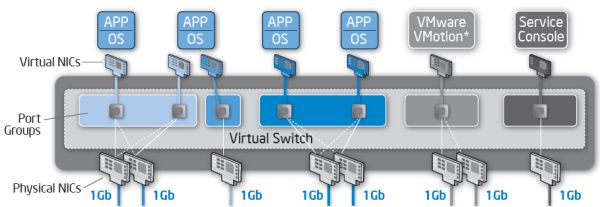10G Ethernet: More Than a Big Pipe
by Johan De Gelas on November 24, 2010 2:34 PM EST- Posted in
- IT Computing
- Networking
- 10G Ethernet
Cleaning Up the Cable Mess
Between 6 and 12 I/O cables on one server is quite a bit. You end up with a complicated NIC configuration as illustrated in this VMware/Intel white paper.
The white paper does not consider the storage I/O, but if you use two FC cards, you are adding another 14W (7W x 2) and two cables. So if we take such a heavy consolidated server as an example you end up with about:
- 10 I/O Cables (without KVM and Server management)
- 2 quad-port NICs x 5W + 2 FC cards x 7W = 24W
24W is not enormous, but in reality this is the best case. Dual socket servers typically need between 200 and 350W, quad socket servers about 250 to 500W in total. So the I/O power consumption is about 5—15% of the total power consumption.
The 10 I/O cables are a bigger problem. The more ports and cables, the higher the chances are that something gets badly configured and the harder it gets to troubleshoot. It does not take much imagination to see that this kind of cabling might waste a lot of sysadmin time and thus money.
The biggest problem is of course cost. Fibre Channel cabling is not cheap, but it is nothing compared to the huge cost of FC HBAs, FC switches, and SFPs. Cabling up to eight Ethernet cables per server is not cheap either: while the cable cost is negligible, someone has to do the pulling and plugging and that task isn't free.











38 Comments
View All Comments
fr500 - Wednesday, November 24, 2010 - link
I guess there is LACP or PAGP and some propietary solution.A quick google told me it's called cross-module trunking.
mlambert - Wednesday, November 24, 2010 - link
FCoE, iSCSI (*not that you would, but you could), FC, and IP all across the same link. Cisco offers VCP LACP with CNA as well. 2 links per server, 2 links per storage controller, thats not many cables.mlambert - Wednesday, November 24, 2010 - link
I meant VPC and Cisco is the only one that offers it today. I'm sure Brocade will in the near future.Zok - Friday, November 26, 2010 - link
Brocade's been doing this for a while with the Brocade 8000 (similar to the Nexus 5000), but their new new VDX series takes it a step further for FCoE.Havor - Wednesday, November 24, 2010 - link
Do these network adapters are real nice for servers, don't need a manged NIC, i just really want affordable 10Gbit over UTP ore STP.Even if its only 30~40M / 100ft because just like whit 100Mbit network in the old days my HDs are more then a little out preforming my network.
Wondering when 10Gbit will become common on mobos.
Krobar - Thursday, November 25, 2010 - link
Hi Johan,Wanted to say nice article first of all, you pretty much make the IT/Pro section what it is.
In the descriptions of the cards and conclusion you didnt mention Solarflares "Legacy" Xen netfront support. This only works for paravirt Linux VMs and requires a couple of extra options at kernal compile time but it run like a train and requires no special hardware support from the motherboard at all. None of the other brands support this.
marraco - Thursday, November 25, 2010 - link
I once made a resume of total cost of the network on the building where I work.Total cost of network cables was far larger than the cost of the equipment (at least with my country prices). Also, solving any cable related problem was a complete hell. The cables were hundreds, all entangled over the false roof.
I would happily replace all that for 2 of tree cables with cheap switches at the end. Selling the cables would pay for new equipment and even give a profit.
Each computer has his own cable to the central switch. A crazy design.
mino - Thursday, November 25, 2010 - link
IF you go 10G for cable consolidation, you better forget about cheap switches.The real saving are in the manpower, not the cables themselves.
myxiplx - Thursday, November 25, 2010 - link
If you're using a Supermicro Twin2, why don't you use the option for the on board Mellanox ConnectX-2? Supermicro have informed me that with a firmware update these will act as 10G Ethernet cards, and Mellanox's 10G Ethernet range has full support for SR-IOV:Main product page:
http://www.mellanox.com/content/pages.php?pg=produ...
Native support in XenServer 5:
http://www.mellanox.com/content/pages.php?pg=produ...
AeroWB - Thursday, November 25, 2010 - link
Nice Article,It is great to see more test around virtual environments. What surprises me a little bit is that at the start of the article you say that ESXi and Hyper-V do not support SR-IOV yet. So I was kind of expecting a test with Citrix Xenserver to show the advantages of that. Unfortunately it's not there. I hope you can do that in the near future.
I work with both Vmware ESX and Citrix XenServer we have a live setup of both. We started with ESX and later added a XenServer system, but as XenServer is getting more mature and gets more and more features we probably replace the ESX setup with XenServer (as it is much much cheaper) when maintenance runs out in about one year so I'm really interested in tests on that platform.